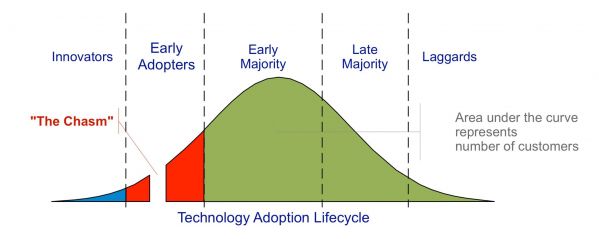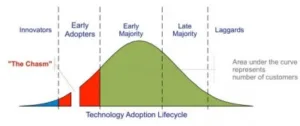When a new technology is introduced through prototypes, demonstrators or even first products, the technology-centric press like the one you are reading right now, soon starts writing about the wonderful new technology and what it can do for the world. ‘The trade’ (us) will focus on the underlying technology and how the new products perform based on some form of measureable characteristic.

Not long after this first introduction to the professional audience, the more consumer-focused media starts carrying the message to the average consumer. Now it is time for the business minded press to do some serious forecasting. “Within X years the Y market will grow to $Z’ is a typical title you will see from market research companies all over the world.
You may wonder how they can forecast a product that will not even sell for a year or so. The answer is pretty simple, experience. Over the years, we have learned how certain technologies have been picked up by consumers. These kinds of growth curves can be applied to the new technology and voila, we have a forecast. Don’t get me wrong, there is nothing wrong with this approach, as long as we realize that this is a guess at this point. There is no production capacity available and we do not have the faintest clue about how the consumer will react to such products.
 Source: Wikimedia.org – Technology Adoption Lifecycle
Source: Wikimedia.org – Technology Adoption Lifecycle
For example the uptake of the LCD TV differed dramatically from the uptake of the tablet PC. One was a long and painful journey, while the other was a swift ‘blitzkrieg’ rattling the PC market to its core. Of course, there was a distinct difference in consumer pricing which makes one more of an investment, while the other made a great holiday gift. When we think back to a product that most have already forgotten, the electronic book reader or EBR for short, we have already forgotten that this device was battling and outselling the tablet for quite some time. A lot of this consumer indecision, for either an EBR or a tablet, may have been caused by not really understanding the differences between the two products.
Coming back to my topic of this article, I never saw an early market forecast that got the tablet or the EBR right. In the beginning they were all underestimating the market success of these products and later nobody foresaw the quick downturn of the EBR in the market. I am not talking of the market forecasts that predict next year’s shipments after the product is already established. I am talking about the market forecast numbers on how big a market will be in 10 years from now. If you know of anyone that predicted these two markets completely right early on, please educate me.
So why does every technology forecast look like a hockey stick? Only small growth sales numbers for the first years and suddenly exponential growth during the mass adoption phase. Well for one, this describes the most successful market introductions of technology products since the first TV sets and follows the “technology adoption curve” as proposed by Everett Rogers et.al. in his book “The Diffusion of Innovation”. Since then a lot of research has gone into this field to aid companies in their marketing efforts for new technologies. And yet, still the hockey curve seems to be the ‘cure all’ for market forecasters.
From my perspective, market forecast is an art, not a science. By art, I mean the insider understanding of the forecaster into the addressable market of such a product and its market penetration potential. I have been guilty of trying to use more numbers to create better forecasts for technology products. There have been great successes as well as epic failures from my side, and I do not believe that anyone has been right all the time. If there is such a person I would love to meet them.
The funny thing is that art and technology do not seem to go together that well. The art part of a forecast is to know what will work and what does not. In other words, the forecast has to be able to be critical about the actual technology performance. This is something that I rarely see expressed by the forecaster. Please keep in mind that the forecasts are created to be sold to the market players. How do you sell a forecast that says there is no way that this will ever be successful? Instead forecasters often create market forecasts that are based on the most optimistic outlook. This will create the highest market forecast, and give start-up companies an opportunity to attract investors. That’s a very important aspect of market forecasts of emerging technologies.
In addition to all of the technology issues, world market conditions change constantly and historic growth rates are not necessarily the best basis for future forecast, which makes forecasting even more of art these days. One of the big drivers is the Internet of course. We are all living in a time where the word about new products spreads so much faster than ever before. For example, the market growth of the LCD TV in India was beginning when the rest of the world had already forgotten what a CRT TV looked like. Today technology blogs in India are discussing if the flexible smartphone is a good fit for India at a time where no one has a flexible smartphone, anywhere.
I see this as a sign of compressing timelines for new product introductions. The world acts much more as a unified market than a multitude of local markets nowadays. If this trend continues we will see even more surprises in technology adoption in coming years than ever before. Now go on and believe the next forecast of the next $100 billion product that will rule the world in 10 years from now. Good luck.
– Norbert Hildebrand

